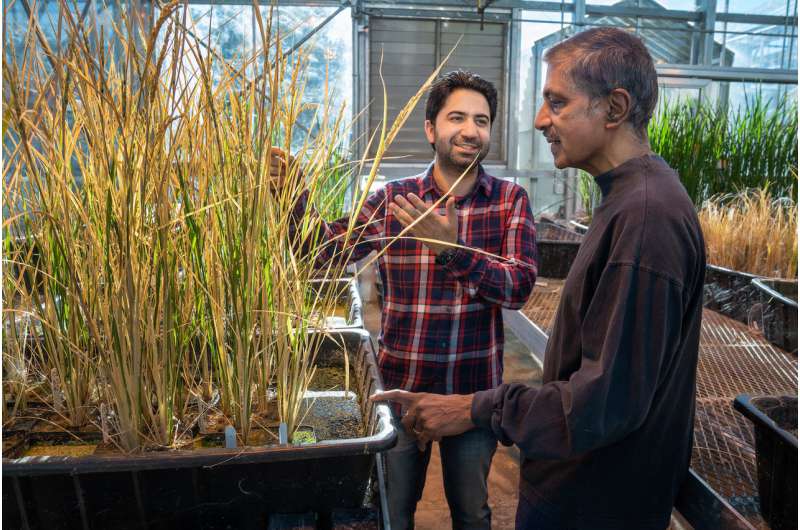Postdoc Imtiyaz Khanday and Professor Venkatesan Sundaresan with cloned rice plants in a UC Davis green house, December 2018. Khanday, Sundaresan and colleagues have solved the problem of propagating cloned, hybrid plants from seed -- a long-sought discovery with big implications for global agriculture. It could make it easier for the world's poorest farmers to grow high-yielding, disease-resistant or climate-tolerant crops and save their seeds for future use. Credit: UC Regents
Plant biologists at the University of California, Davis have discovered a way to make crop plants replicate through seeds as clones. The discovery, long sought by plant breeders and geneticists, could make it easier to propagate high-yielding, disease-resistant or climate-tolerant crops and make them available to the world's farmers.
The work is published Dec. 12 in the journal Nature.
Since the 1920s, many crops have been grown from hybrid seeds created by crossing two varieties. These hybrids can have superior qualities in areas such as yield or pest resistance. But the seeds of hybrid crops do not produce plants with the same qualities.
The ability to produce a clone, an exact replica, of a plant from its seeds would be a major breakthrough for world agriculture. Instead of purchasing expensive hybrid seeds each year, which is often beyond the means of farmers in developing countries, farmers could replant seeds from their own hybrid plants and derive the benefits of high yields year after year.
About 400 species of wild plants can produce viable seeds without fertilization. Called apomixis, this process seems to have evolved many times in plants—but not in commercial crop species.
The discovery by postdoctoral researcher Imtiyaz Khanday and Venkatesan Sundaresan, professor of plant biology at UC Davis and colleagues at UC Davis, the Iowa State University and INRA, France is a major step forward.
"It's a very desirable goal that could change agriculture," Sundaresan said.
"Baby boom" gene is key
Khanday and Sundaresan discovered that the rice gene BBM1, belonging to a family of plant genes called "Baby Boom" or BBM, is expressed in sperm cells but not in eggs. After fertilization, BBM1 is expressed in the fertilized cell but—at least initially—this expression comes from the male contribution to the genome.
BBM1, they reasoned, switches on the ability of a fertilized egg to form an embryo.
The researchers first used gene editing to remove the ability of the plants to go through meiosis, so that the egg cells formed instead by mitosis, inheriting a full set of chromosomes from the mother.
Then they caused these egg cells to express BBM1, which they would not normally do without fertilization.
"So we have a diploid egg cell with the ability to make an embryo, and that grows into a clonal seed," Sundaresan said.
So far the process has an efficiency of about 30 percent, but the researchers hope that can be increased with more research. The approach should work in other cereal crops, which have equivalent BBM1 genes, and in other crop plants as well, Sundaresan said.
More information: Imtiyaz Khanday et al, A male-expressed rice embryogenic trigger redirected for asexual propagation through seeds, Nature (2018). DOI: 10.1038/s41586-018-0785-8
Journal information: Nature
Provided by UC Davis























